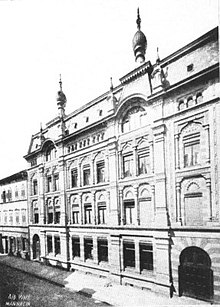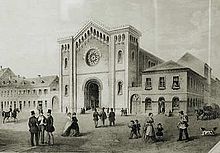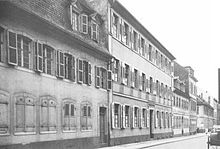Jewish community Mannheim


The Jewish Community of Mannheim is a Kehillah that has existed in Mannheim ( Baden-Württemberg ) since the middle of the 17th century .
Historical development
1650-1700
In Mannheim, five Jewish families from Pfeddersheim were accepted into the city for the first time in 1652 , the first synagogue was built around 1660 and the Jewish cemetery was laid out in 1661. The first settlement is expressly mentioned in Article 10 of the first Mannheim Jewish concession of September 1, 1660, which was issued by Elector Karl I. Ludwig for the German Jews and in a 13-point program the rights and obligations of the Germans who are already resident and who are still moving here Jews governed. They were thereby granted comparatively extensive freedoms and placed on an equal footing with city citizens. Just a few years later, this settlement - like the entire city - was destroyed by the French during the War of the Palatinate Succession in March 1689.
1700-1800
The residents fled and resettlement did not begin until about ten years later around 1700, when a new synagogue could already be inaugurated. Researching the origin of the immigrant Jews is difficult because Jews did not have uniform surnames and they usually had to live in different places from generation to generation, especially if the sons bought or renewed the letter of protection (“Schutzjude”) and with it the temporary right of residence in their city of birth was denied.
The immigration of Jewish families to Mannheim around 1700 was made possible in particular by the concession of October 31, 1698, with which Elector Johann Wilhelm (ruled 1690–1716) raised the previous maximum number of Jewish families from 84 to 150. In addition to the capital to build a house, he also demanded the possession of at least 1000 thalers in order to encourage the settlement of wealthy Jews as far as possible. On the other hand, under pressure from Christian fellow citizens, the Jews were forbidden by the Mannheim city council from 1717 to show their wealth publicly. They were forbidden to “wear precious dresses and cloaks of damask and silk” , although they “lived in the most beautiful palaces and houses in the most elegant streets and celebrated their weddings with the greatest pomp.” Most families did not come in until the middle of the 18th century the city, especially since Elector Karl III. Philipp (ruled 1716–1742) increased the maximum number of Jewish families to 200 on May 23, 1717 - about one eighth of the total population - and the relocation of the residence to Mannheim in 1720 gave the city, which was still suffering from the consequences of the war, a new economic boom.
For example, the progenitor of the Mayer family of manufacturers, Elias Hayum , came to Mannheim from Stuttgart around 1740, and the later so-called Ladenburg family , owners of the Ladenburg bank , to which Mannheim's honorary citizen Carl Ladenburg also belonged, came from Ladenburg , a neighboring town of Mannheim , in 1760 .
By 1750 there were already 18 Jewish court factors in Mannheim . In 1780 Mannheim, also known as the “German Jerusalem” , was one of the only cities with more than 1000 Jewish community members , along with Frankfurt am Main , Hamburg , Fürth in Bavaria, Zülz (Neustadt district, Upper Silesia ) and Glogau ( Lower Silesia ).
1800-1900
In 1809, through a state edict of the Grand Duchy of Baden, “the Jews” of Baden were first written as a corporate religious community with its supreme body “Oberrath”; as are the Jewish communities in Baden, these are "subordinate to" the upper council. In 1809, according to an official census, exactly 1095 Jewish citizens lived in Mannheim. Around 1830 their share was around 7% of the total population (20,000 inhabitants), of which around two thirds were active in trade. In general, the Jewish inhabitants played a significant role in Mannheim's economic boom in the 19th century: Jewish cloth, iron, grain and tobacco trading companies were founded, cigar factories - see Gottschalk Mayer (1761–1835) and his “Gebr. Mayer cigar factories ”- and distilleries were opened, the Ladenburg bank financed numerous industrial projects. The publishing house founded in 1838 by J. Bensheimer (legal and political literature) and the Rhenish rubber and celluloid factory of the Bensinger brothers enjoyed world renown.
In 1827 the Mannheim district rabbinate was established , which only included the Jewish city of Mannheim.
In 1875 there were 3943 Jewish residents in Mannheim, corresponding to 6.6% of the total population. Mannheim Jewry played an important role in all areas of city life, including through various foundations that could finance or generously endow some facilities such as the Herschelbad, the city art gallery , the Reiss Museum and the city library.
Since 1900
With 6972 members, the Israelite religious community in Mannheim was numerically the largest in Baden in 1925. Since the beginning of the nineteenth century, the Jewish community has had an equal place alongside the Christian religious communities in the urban boom in the city. The names of Jews were associated with leading industrial companies, important social and cultural foundations, and were found in political bodies ranging from local self-government to the Reichstag.
General mood in Mannheim around 1930
The mood in Mannheim was generally not very anti-Semitic due to the Mannheim social structure (a large part of the population came from the working class). Therefore, the National Socialists in the North Baden region emphasized the administrative side of the persecution more strongly. However, there were also “wild” methods, such as B. can be seen in the displacement of Jews from business life.
Development of the Mannheim Jews after the National Socialists came to power
The community reacted armed. However, there was no specific reference to this significant event in the parish gazette. The first criticism was only found there after the anti-Jewish laws were passed. Inside, the church suffered from the beginning. They began to build a “Jewish world” with their own schools, their own senior citizens' home and hospital. Associations were founded to provide for the Jews without income.
November pogroms 1938
During the November pogroms in 1938 ( November 9th / 10th) the Mannheim synagogue was blown up and the Feudenheim synagogue was set on fire. Shops and homes of Jews were looted and their belongings burned. Leading community members fled or were deported to Dachau .
1940 - To the deportations to Gurs
After the conquest of France on August 2, 1940, Alsace went to Gauleiter Robert Wagner (Gau Baden) to form a new Gau "Upper Rhine" and Lorraine to Josef Bürckel (Gau Saarpfalz) to form a new Gau "Westmark". As part of the armistice agreement with France on June 22, 1940, it was agreed that all French Jews should be deported from the German occupation areas to the interior of France. By mid-September 1940 over 23,000 French were deported from the occupied territories. On the occasion of a meeting between the two Gauleiter in the Reich Chancellery on September 25, 1940, Hitler asked them to ensure that their areas were made “ free of Jews ”. Both decided in a concerted action to extend the deportations to include Jews living in the Reich. As part of the " Wagner-Bürckel-Aktion ", the last Germans of Jewish faith living in Mannheim and the whole area were picked up on October 22, 1940 by criminal investigators (Gestapo), brought to assembly camps in Heidelberg, Mannheim and Karlsruhe and in seven Trains deported to Gurs via Belfort . Only a few managed to escape from there. Many died of hunger and disease. In August 1942, transports to the gas chambers of Auschwitz and Lublin-Majdanek were arranged from there .
Life of the Jewish community after the collapse of the actual community
The hospital and old people's home were costly but of increasing importance to the community. However, the hospital was confiscated in 1941 and the retirement home was closed shortly afterwards as a result of deportations. By 1940 around 4,000 Jews had managed to emigrate or flee abroad. 2300 people from the Jewish cultural area fell victim to National Socialism in Mannheim. Of the 1,244 Jewish businesses before the seizure of power, 64 remained until March 1, 1939, ie they were still profitable or not yet “Aryanized”.
After 1945
The reestablishment of the Jewish community after the Nazi persecution took place with only 120 members. When an Angel of Peace was erected in 1952 , the message of the memorial was still very controversial. The then Lord Mayor Hermann Heimerich (1885–1963) wanted to create a place of public mourning and communal remembrance for the population. The monument was intended to contribute to the reconciliation of the nation divided on the question of how to deal with the past. The sculpture, created by the sculptor Gerhard Marcks and inaugurated in the presence of Federal Chancellor Konrad Adenauer on the memorial day, was finally moved in May 1983 from its more prominent location in B 4 in the shadow of the Jesuit Church to E6.
In the mid-1950s, the Jewish community was able to build a new prayer room on Maximilianstrasse, which was consecrated in 1957. It was the second new synagogue to be built in southwest Germany after the Holocaust. The former Lord Mayor Hermann Heimerich had made a significant contribution to the realization of the project . In 1987 the new Mannheim synagogue was finally inaugurated. A memorial was erected in the Mannheimer Planken in 2003. The names of the Jewish victims of National Socialism in Mannheim are written in mirror writing on the glass cube . The cube itself was set up at an angle so that it points to the center of the parade ground. In 2012 the congregation had around 500 members.
Cantors
- from 1922 to 1938: Hugo Chaim Adler
- 1977, 1978, 1979, 1980: Gerald Rosenfeld
- from 1985 to March 31, 2014: Raffaele Polani
- from April 2014 to March 31, 2017: Moshe Hayoun
- since April 2017: Amnon Seelig
Jewish personalities in Mannheim
- Isaac Brilin (1628–1678), first rabbi (1671–1678)
- Friedrich Julius Bensinger (1841-1891), entrepreneur, co-founder of the Rheinische hard rubber goods factory
- Adolf Bensinger , entrepreneur, co-owner of the Rheinische Gummi- and Celluloidfabrik, art collector
- Carl Bensinger , entrepreneur, co-owner of the Rheinische Gummi- and Celluloidfabrik
- Ladenburg family , Jewish banking family
- Bernhard Kahn (1827–1905), city councilor, through whose legacy the reading room was created
- Bernhard Herschel (1837–1905), tobacco wholesaler, founder of the Herschelbad
- Viktor Lenel (1838–1917), industrialist, President of the Chamber of Commerce and Industry
- Hermann Levi (1839–1900), conductor, pianist, composer
- Richard Lenel (1869–1950), industrialist, President of the Chamber of Commerce and Industry 1920–23
- Julius Moses (1869–1945), doctor and curative teacher, school reformer
- Ludwig Landmann (1868–1945), first city counsel of Mannheim, Lord Mayor of Frankfurt am Main 1924–1933, victim of National Socialism
- Ludwig Frank (1874–1914), lawyer and member of the Reichstag (SPD)
- Fritz Cahn-Garnier (1889–1949), Lord Mayor of Mannheim, Minister of Finance of Württemberg-Baden
- Max Silberstein (1897–1966), public prosecutor, judge, concentration camp survivor, later president of the Mannheim Regional Court and the Karlsruhe Higher Regional Court
- Max Grünewald (1899–1992), rabbi
- Paul Eppstein (1902–1944), sociologist, director of the Mannheim Adult Education Center, victim of Nazi Germany
- Max Diamant (1908–1992), journalist, social democratic or socialist party official and trade unionist
- Nathan Peter Levinson (1921–2016), rabbi and Jewish military chaplain
See also
Individual evidence
- ↑ MARCHIVUM : Chronicle star . 1655, Retrieved September 27, 2018 .
- ↑ MARCHIVUM: Chronicle star . 1660, accessed September 27, 2018 .
- ↑ MARCHIVUM: Chronicle star . 1661, Retrieved September 27, 2018 .
- ^ Corinna Hiss: Right in the middle of Jewish life , Mannheimer Morgen , November 16, 2012, p. 35
- ^ Hugo Chaim Adler. In: Lexicon of persecuted musicians from the Nazi era
- ↑ MARCHIVUM: Chronicle star . November 14, 1979. Retrieved September 27, 2018 .
- ^ Birgit Rechlin: Mannheim. Jewish community. Karl-Wörn-Haus Museum director Birgit Rechlin presents an important exhibit from the special exhibition "Simon Eichstetter - Jewish Life in Schwetzingen". , Article from May 15, 2015 in Mannheimer Morgen.
- ↑ Chief Cantor Gerald Rosenfeld - How beautiful are your tents, Jakob part of a public concert on June 26th, 1997 in Mannheim
- ↑ MARCHIVUM: Chronicle star . October 23, 1980. Retrieved September 27, 2018 .
- ↑ Christine Maisch-Straub: Mannheim. Jewish community. Chief Cantor Raffaele Polani resigns , article from April 23, 2014 in Mannheimer Morgen.
- ↑ Christine Maisch-Straub: Mannheim. Jewish community. Introductory service at the weekend for Moshe Hayoun / religion and song play a central role in his family. The new cantor comes from Strasbourg , article from September 20, 2014 in Mannheimer Morgen
- ↑ Harald Raab: Mannheim. Well protected in the square. The community center was opened 30 years ago , article from August 24, 2017 in Jüdische Allgemeine
literature
- Tilde Bayer: The place in the synagogue. In: Sylvia Schraut (Hrsg.): Stadt und Land. Images, stagings and visions in the past and present. Wolfgang von Hippel on his 65th birthday. Kohlhammer, Stuttgart 2001, ISBN 3-17-017153-4 , pp. 239-253 (= publications by the Commission for Historical Regional Studies in Baden-Württemberg. Series B: Research 147).
- Tilde Bayer: minority in urban areas. Social history of the Jews in Mannheim during the first half of the 19th century. Jan Thorbecke Verlag, Stuttgart 2001, ISBN 3-7995-0904-6 (= sources and representations on Mannheim's city history 6)
- Hans-Joachim Fliedner: The persecution of the Jews in Mannheim 1933–1945. Published by the Mannheim City Archives. 2 volumes. 2nd Edition. Kohlhammer, Stuttgart et al. 1991, ISBN 3-17-011506-5 ( publications of the Mannheim City Archives 1/2).
- Martina Fuchs: October 22, 23, 1940. Deportation of Mannheim Jews to Gurs. 2nd revised edition. School administration office, Mannheim 2000 (= school in Mannheim 2, ZDB -ID 1090684-8 ).
- Hans-Joachim Hirsch: “I called you by your name.” The memorial sculpture for the Jewish victims of National Socialism in Mannheim. Brandt publishing office, Mannheim 2005, ISBN 3-926260-65-3 (= small writings of the Mannheim City Archives 23).
- Volker Keller: Pictures of Jewish life in Mannheim. Edition Quadrat, Mannheim 1988, ISBN 3-923003-43-9 (= special publication of the Mannheim City Archives 19).
- Monika Ryll: Lukas Strauss. Baden bourgeoisie in the Empire. Brandt publishing office, Mannheim 1996, ISBN 3-926260-25-4 (= small writings of the Mannheim City Archives 3).
- Friedrich Teutsch: History of the Jewish community from the Peace of Westphalia to the Weimar Republic as reflected in the square F3. In: Oberrat der Israeliten Baden (Hrsg.): Jüdisches Gemeindezentrum Mannheim F 3. Festschrift for the inauguration on September 13, 1987, 19th Ellul 5747. Brandt Publishing Office, Mannheim 1987, ISBN 3-926260-01-7 , p. 17 -38.
- Shulamit Volkov : The Jews in Germany 1780–1918. Oldenbourg, Munich 1994, ISBN 3-486-55059-4 (= Encyclopedia of German History 16), (2nd improved edition, ibid. 2000, ISBN 3-486-56481-1 ).
- Florian Waldeck : Old Mannheim families. 6 volumes. Familiengeschichtliche Vereinigung, Mannheim 1920–1925 (reprint in 2 volumes. Society of Friends of Mannheim, Mannheim 1987).
- Karl Otto Watzinger : History of the Jews in Mannheim 1650-1945. With 52 biographies. With an overview of the sources in the Mannheim City Archives on the history of the Jews by Jörg Schadt . Kohlhammer, Stuttgart et al. 1984, ISBN 3-17-008696-0 (= publications of the Mannheim City Archives , 12).
- Moshe Zimmermann : History of German Jewry 1914–1945 . Oldenbourg, Munich 1997, ISBN 3-486-55080-2 (= Encyclopedia of German History , 43), p.



